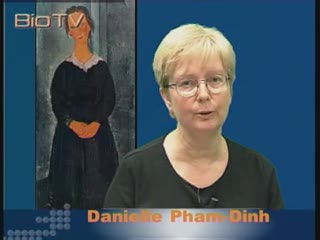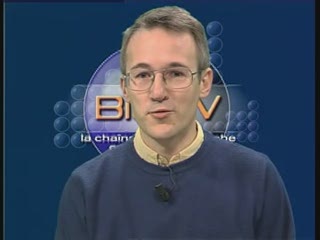Pham-Dinh, Danielle
-Habilitation à diriger des recherches, soutenue le 4 décembre 1998, UFR Necker Enfants-Malades, Université de Paris V.
-Recrutement par voie de détachement dans le corps des chargés de recherche de première classe à l'INSERM, à l'URA 1488 du CNRS (IDN) en 1992.
-DR2 INSERM depuis décembre 1998.
-Participation au clonage du cDNA de PLP et à la mise en évidence de la mutation Jimpy (FEBS 1985, Nature 1986, Embo.J 1986)
-Mise en évidence de mutations du gène PLP dans la maladie de Pelizaeus-Merzbacher (PNAS 1991, Hum Mol Genet 1993)
-Modèle topologique du PLP (J. Memb. Biol. 1991)
Maladie de Charcot-Marie-Tooth
-Clonage et localisation du gène P0 humain (Hum Mol Genet 1993)
-Caractérisation de mutations dans trois gènes de la myéline impliqués dans le CMTI (7 articles)
-Participation à l'étude fonctionnelle des mutations de la Cx32. (J. Neurosci. 1998)
Etude de la Myelin Oligodendrocyte Glycoprotein (MOG)
-Clonage du cDNA et du gène MOG dans plusieurs espèces, localisation de ce gène dans le Complexe Majeur d'Histocompatibilité. (PNAS 1993, Genomics 94, 95; J Neurochem 94; Immunogenetics 95).
-Etude de l'autoimmunité (EAE) par utilisation d'une lignée de souris dont le gène MOG a été inactivé, générée au laboratoire.
Caractérisation d'une leucodystrophie d'origine inconnue, le CACH (Acta Neuropathologica, 1999)
Exemples de publications de l'équipe de Neurogénétique moléculaire.
Pham-Dinh D., Popot J-L., Boespflug-Tanguy O., Landrieu P., Boué J., Deleuze J-F., Jollès P., Dautigny A. Pelizaeus-Merzbacher disease: a Valine to Phenylalanine point mutation in a putative extracellular loop of myelin proteolipid. Proc Natl Acad Sci USA, 1991, 17:7562-7566.
Popot J-L., Pham-Dinh D., Dautigny A. Major myelin proteolipid: the 4-alpha-helix topology. J Membrane Biol, 1991, 120:233-246.
Pham-Dinh D., Mattei M-G., Nussbaum J-L., Roussel G., Pontarotti P., Roeckel N., Mather I-H., Artzt K., Fischer Lindahl K., Dautigny A. Myelin/oligodendrocyte glycoprotein is a member of a subset of the Ig superfamily encoded within the Major Histocompatibility Complex. Proc Natl Acad Sci USA, 1993, 90:7990-7994.
Pham-Dinh D., Jones E., Pitiot G., Della Gaspera B., Daubas P., Mallet J., Le Paslier D., Fischer Lindahl K., Dautigny A. Physical mapping of human and mouse MOG gene at the distal end of the MHC class 1b region. Immunogenetics, 1995, 42:386-391.
Blanquet-Grossard F., Pham-Dinh D., Dautigny A., Latour P., Bonnebouche C., Diraison P., Chapon F., Chazot G., Vandenberghe A. Charcot-Marie-Tooth type 1B neuropathy: a mutation at the unique glycosylation site in the major peripheral myelin glycoprotein P0. Hum Mut, 1996, 8:185-186.
Rodriguez D., Della Gaspera B., Zalc B., Hauw J-J., Fontaine B., Edan G., Clanet M., Dautigny A., Pham-Dinh D., the Réseau de Recherche Clinique sur la Susceptibilité Génétique à la Sclérose en Plaques. Identification of a Val145Ile substitution in the human myelin oligodendrocyte glycoprotein: lack of association with multiple sclerosis. Mult Scler, 1997, 3:377-381.
Ressot C., Gomez D., Dautigny A., Pham-Dinh D., Bruzzone R. Connexin32 mutations associated with X-linked charcot-marie-tooth disease show two distinct behaviors: loss of function and altered gating properties. J. Neurosci, 1998, 18: 4063-4075.
Della Gaspera B., Pham-Dinh D., Roussel G., Nussbaum J-L., Dautigny D.. Membrane topology of the Myelin/Oligodendrocyte Glycoprotein. Eur J Biochem 258: 478-484, 1998.
Rodriguez D., Gelot A., Della Gaspera B., Robain O., Ponsot G., Sarliève L., Folhen M., Pompidou A., Dautigny A., Aubourg P., Pham-Dinh D. Neuropathological and biochemical study of two cases of "CACH" (Childhood Ataxia with diffuse Central nervous system Hypomyelination) syndrome. Acta Neuropathol. 197:469-480, 1999.
Vidéos
La cellule de Schwann.
Son interaction avec les nerfs passe par un vocabulaire (neuromédiateurs...) et une grammaire (récepteurs, canaux ioniques...) qui modulent les transmissions nerveuses et synaptiques. La vision
Les cellules gliales centrales
Cellules gliales et neurones ont une origine moins mouvementée, mais aussi en partie commune. Leurs destins sont inséparables, leurs fonctions sont complémentaires et sans cellules gliales, le neurone


